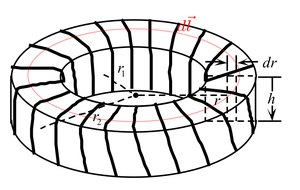Difference between revisions of "Chapter 30 Problem 13"
From 105/106 Lecture Notes by OBM
| (One intermediate revision by the same user not shown) | |||
| Line 11: | Line 11: | ||
==Solution== | ==Solution== | ||
[[File:Chapter30Problem13s.png|300px|center|Toroid]] | [[File:Chapter30Problem13s.png|300px|center|Toroid]] | ||
| + | Magnetic field inside as a function of <math>r</math>: | ||
<math>\oint \vec{B}.d\vec{l}=\mu_0 I_{\textrm{encl}}</math> | <math>\oint \vec{B}.d\vec{l}=\mu_0 I_{\textrm{encl}}</math> | ||
| + | |||
| + | <math>B (2 \pi r)=\mu_0 NI</math> | ||
| + | |||
| + | <math>B=\frac{\mu_0 NI}{(2 \pi r)}</math> | ||
| + | |||
| + | the self-inductance is related to the flux is the integral of the magnetic field over a cross-section of the toroid. | ||
| + | |||
| + | <math>L=\frac{N\Phi_B}{I}=\frac{N}{I}\int_{r_1}^{r_2}\frac{\mu_0 NI}{(2 \pi r)}hdr=\frac{\mu_0 N^2 h}{2\pi}\ln\frac{r_2}{r_1}</math> | ||
Latest revision as of 21:49, 5 May 2019
Problem
A toroid has a rectangular cross section. Show that the self-inductance is
where is the total number of turns and , , and are shown above. [Hint: Use Ampère’s law to get as a function of inside the toroid, and integrate.]
Solution
Magnetic field inside as a function of :
the self-inductance is related to the flux is the integral of the magnetic field over a cross-section of the toroid.












